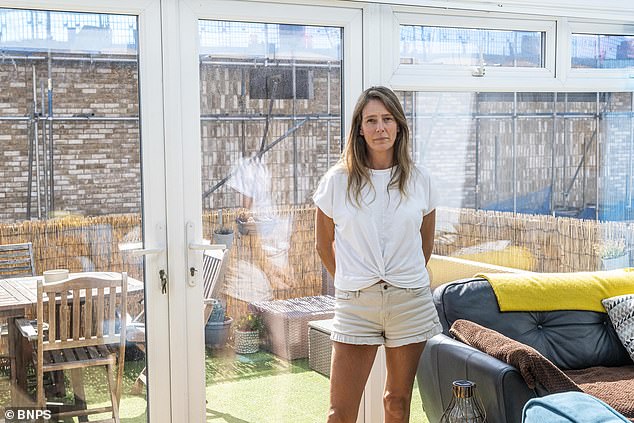There are few greater horrors for any homeowner than buying a place with a beautiful view only for it to be blocked out by a new development or an inconsiderate neighbour slapping up an unsightly extension.
Not least because homes with a view can attract a premium of £88,000 on average when it comes time to sell, according to property website Rightmove.
Growing numbers of homeowners are likely to find themselves facing this situation as Labour relaxes planning rules and increases the likelihood of new developments – even in picturesque rural locations.
But there are ways you can protect a pretty countryside or sea view from development.
Money Mail, with the help of top property lawyers, reveals ways to protect your view before you buy – and fight back if it is in peril afterwards…

Blocked: Liz Bates (pictured), from the Southbourne area of Bournemouth, Dorset, has had her panoramic sea view replaced by a brick wall
Check for a covenant
Owning a property does not give you an automatic legal entitlement to keep the surrounding land undeveloped or your view unobstructed – however picturesque it is.
If your neighbour builds on their own land and gets the correct permissions, the law generally allows it, even if it spoils your view or affects your property’s value.
This means you will need to be resourceful in finding clever ways to get around it.
Finding a restrictive covenant is one helpful trick. These are written into a property’s title deeds and are a binding promise not to do something.
For example, a restrictive covenant could state the owner must promise ‘not to build on the land anything more than a one-bed residence’ or ‘no structures to be erected which may obstruct the outlook from number five’.
A restrictive covenant is usually created at the point of sale when the owner of a large parcel of land subdivides it to sell some and then keep the rest. They are rare, but can be enforced through the civil courts.
However, even if you find one, you might not be out of the woods.
Mike Hansom, a solicitor specialising in property disputes at law firm BLB Solicitors, says: ‘Seasoned developers know all this and they will take advice from their own legal team to challenge the existence of the covenant.
‘If there is one, it does not necessarily mean you will be able to appeal a new development.’
A developer can get around a restrictive covenant by modifying it to make it unusable.
They could say the rationale behind that covenant no longer applies today – for example, if there once were sheep in a field so it was a farm but they are no longer there, or that the land was once in the countryside but now is on the edge of a city due to towns being built up around it.
You can bring legal action yourself to enforce a restrictive covenant. Should the case end up in the Upper Tribunal, the court will examine how much the covenant beneficiary objects to the plans, the extent of the potential loss and any disregard for the rights of others.
You can find out whether the land has a restrictive covenant by visiting the Land Registry’s website (gov.uk/get-information-
about-property-and-land) and downloading the official copy of the registry of title (the deed). It costs £7.
Register land as village green
To protect your view, you could apply to register the land as a town or village green.
You will need to provide evidence showing the land has been used by a significant number of local people for recreation – for example, by hosting fetes and summer fairs or picnics – for at least 20 years.
‘If someone has an early inkling that there’s going to be a development, they should galvanise local interest in registering to apply the land as a town or village green,’ says Mr Hansom.
This could block a person or a developer from building on it.
Anyone can apply under section 15(1) of the Commons Act 2006. You can apply to the commons registration authority eg. your county council.
However, if there are already developers looking to build on the land, they may have put an application in to block land being registered as a town or village green.
For the developer to be able to block an application for town and village green status, a year must have passed in which local people have not complained about the development.
Make a right to light claim
Property owners have a legal right to light as set out in the Rights of Light Act 1959.
Every window in a building acquires a right to light after it has existed for 20 years.
If your neighbour wants to build a large extension or outhouse which is going to restrict the amount of daylight coming into the windows, you could seek an injunction order to stop that structure from being built.
It must be an actionable interference of light coming in through your windows. This means the light impacts the activities you do in that room, rather than the law giving you a right to a certain amount of sunlight shining through the window.
Mr Hansom says: ‘The new structure would need to be pretty close to the property boundary and the windows to have an actionable claim.
‘If it’s a massive tower block going right up against your garden you might have a claim.’
You will need to demonstrate that the usual activities of that room are made much harder if you do not switch on a light.
‘If you are a keen artist using a room as a studio, that would be the kind of situation where you might have a better claim. If it’s a bedroom it’s not going to matter as much if light is restricted,’ Mr Hansom adds.
You will need a right to light survey carried out and a model of the obstruction made by software, which can cost up to £750.
Object to the application
You can raise objections to a wall, building or anything which will block your view during the planning application stage, although these are judged on planning grounds, not loss of view alone.
When someone applies for planning permission, the local council invites comments from neighbours and the public.
You can submit an objection if you believe the development would be overbearing or out of scale with the area, cause loss of privacy or overshadowing, harm local heritage or protected landscapes, or breach green belt restrictions or height limits.
If you live in an area that has been designated an Area of Outstanding Natural Beauty you may have a better chance of appealing.
While loss of a view on its own isn’t a valid reason for refusal, councils sometimes take it indirectly into account if it relates to visual appeal, character of the area, or overdevelopment.
Reema Chugh, a solicitor at Hodge Jones & Allen, says: ‘If the site is in a conservation area, Area of Outstanding Natural Beauty, or near a listed building, planning officers may be stricter about preserving open outlooks.’
Look out for tell-tale signs
You can do a bit of detective work before buying a property to reduce the risk of a future blocked view.
Drive around the area and you will get an idea of whether the planning policy is geared up for large-scale developments.
Olivia Egdell-Page, a solicitor at Joseph A Jones & Co, says: ‘For example, there are areas near where I am based where there are hundreds of houses being built.
‘This may give an indication as to whether large-scale developments are likely. However, individual owners may still decide to undertake works to their property at any time.’
Research the Local Plan and Neighbourhood Plan of an area before you buy as these set out where the council expects future housing growth.
Check the planning history as rejected applications can hint that someone might try again later. Also look at land ownership. Empty plots, large gardens, or agricultural land next to homes may be candidates for development.
Your conveyancing solicitor can see if the land is ‘allocated for development’ in the Local Plan.
- Is your home’s view at risk of obstruction? Contact helen.kirrane@thisismoney.co.uk

#steps #stop #neighbours #greedy #developers #ruining #homes #picturesque #view


















